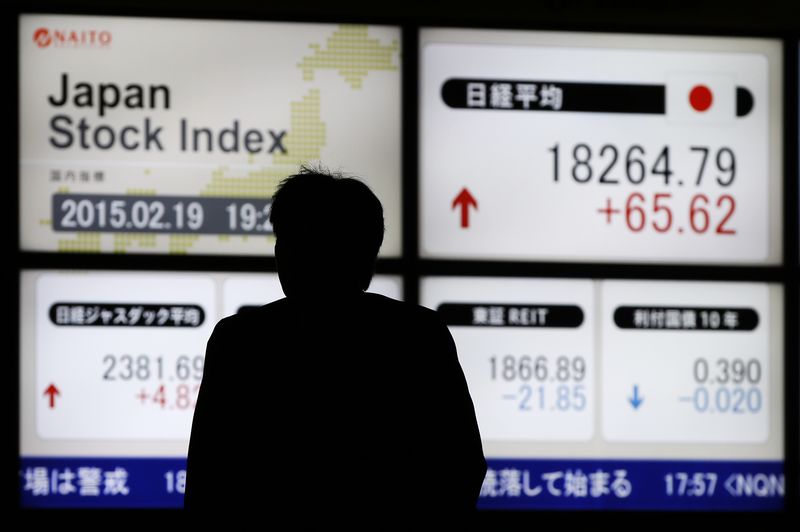* MSCI Asia-Pacific index down 1.5 pct, Nikkei drops 0.5 pct
* Spreadbetters expect European stocks to open lower
* Asia hit as Wall St tumbles on trade woes, growth concerns
* Oil falls as trade woes stoke demand concerns
By Shinichi Saoshiro
TOKYO, Dec 5 (Reuters) - Asian stocks slid across the board on Wednesday, dragged down by Wall Street's tumble as sharp declines in long-term U.S. Treasury yields and resurgent trade concerns stoked investor worries about global economic growth.
Spreadbetters expected European stocks to open lower, with Britain's FTSE .FTSE losing 0.9 percent, Germany's DAX .GDAXI falling 1.2 percent and France's CAC .FCHI retreating 1 percent.
Global equities have been shaken as a flattening U.S. Treasury yield curve fans worries about a recession, and on growing doubts that Washington and Beijing will be able to clinch a substantive trade deal during a temporary cease-fire agreed at the weekend.
MSCI's broadest index of Asia-Pacific shares outside Japan .MIAPJ0000PUS fell 1.5 percent.
The Shanghai Composite Index .SSEC slipped 0.6 percent and Japan's Nikkei .N225 dropped 0.5 percent.
Australian stocks .AXJO lost 0.8 percent, pressured by global losses. The mood further soured after data showed Australia's third-quarter growth fell short of expectations. The Australian dollar AUD=D4 was down 0.7 percent at $0.7288. Dow .DJI retreated 3.1 percent and the Nasdaq .IXIC sank 3.8 percent on Tuesday. U.S. financial shares .SPSY , which are particularly sensitive to bond market swings, dropped 4.4 percent. .N
Following Wall Street's overnight tumble, S&P e-mini futures ESc1 nudged up 0.3 percent in Asian trade on Wednesday.
Signals from the Federal Reserve last week that it may be nearing an end to its three-year rate hike cycle has pushed the 10-year U.S. Treasury yield US10YT=RR to three-month lows below 3 percent.
Concerns about slowing U.S. growth have accelerated the flattening of the yield curve, a phenomenon in which longer-dated debt yields fall faster than their shorter-dated counterparts.
The spread between the two-year and 10-year Treasury yields was at its flattest level in more than a decade and edging closer to an inversion, when long rates fall below short rates.
"The market decline in the U.S. overnight and the flattening of the yield curve reflect that economic growth momentum is taking over as the primary concern for investors, even as the latest ISM manufacturing data is holding up well," wrote Tai Hui, market strategist at J.P. Morgan Asset Management.
A flatter curve is seen as an indicator of a slowing economy, with lower longer-dated yields suggesting that the markets see economic weakness ahead.
According to the Cleveland Federal Reserve, an inverted yield curve has preceded the last seven U.S. recessions.
It is not a sure indicator, however, with an inversion in 1966 and a very flat curve in 1998 failing to lead to recessions.
"The U.S. economy is likely to be able to withstand another rate hike or two, therefore, the flattening of the Treasury curve looks a little over done. That said, it is true that the economic outlook is murkier than before," said Masahiro Ichikawa, senior strategist at Sumitomo Mitsui Asset Management.
"There is also Brexit to keep an eye on, and this is a factor in the ongoing risk aversion."
British Prime Minister Theresa May suffered embarrassing defeats on Tuesday at the start of five days of debate over her plans to leave the European Union that could determine the future of Brexit and the fate of her government. markets were also weighed down as optimism faded over a truce made over the weekend between U.S. President Donald Trump and Chinese President Xi Jinping.
Trump threatened on Tuesday to place "major tariffs" on Chinese goods imported into the United States if his administration is unable to reach an effective trade deal with Beijing. doubts grew over whether the two sides can resolve their differences, China said on Wednesday it was confident that it can clinch a trade deal with Washington within the 90-day negotiating window that the two sides agreed. would raise the spectre of fresh U.S. tariff action and potential Chinese retaliation as early as March.
The U.S. currency bounced modestly after slipping the previous day on lower Treasury yields.
The dollar index against a basket of six major currencies .DXY was 0.2 percent higher at 97.144 after stooping to a near two-week low of 96.379 overnight.
The greenback rose 0.25 percent to 113.06 yen JPY= after losing 0.75 percent the previous day against the safe-haven Japanese currency.
The pound was down 0.5 percent at $1.2685 GBP=D4 having touched a 17-month low of $1.2659 overnight, rattled by Brexit setbacks in parliament.
Oil prices fell, weighed down by swelling U.S. inventories and concerns that slowing economic activity will sap demand for commodities. O/R
U.S. crude futures CLc1 were down 1.65 percent at $52.37 per barrel and Brent LCOc1 shed 1.75 percent to $61.00 per barrel.
<^^^^^^^^^^^^^^^^^^^^^^^^^^^^^^^^^^^^^^^^^^^^^^^^^^^^^^^^^^^ US Treasury yield curve
https://tmsnrt.rs/2RAJIgP
^^^^^^^^^^^^^^^^^^^^^^^^^^^^^^^^^^^^^^^^^^^^^^^^^^^^^^^^^^^> (Editing by Kim Coghill and Jacqueline Wong)
